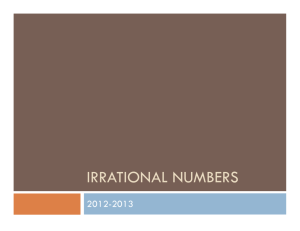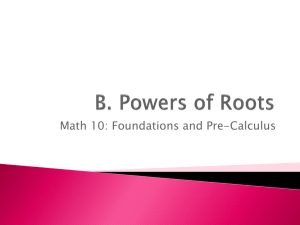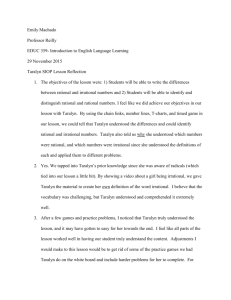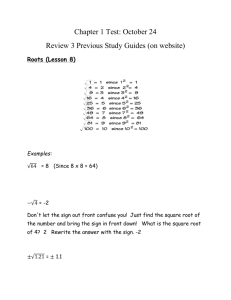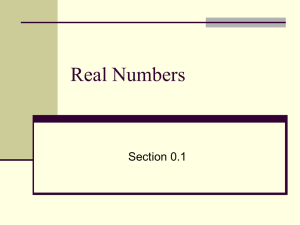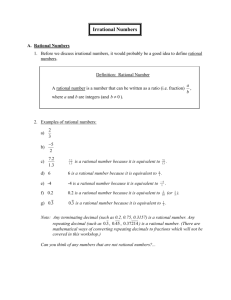Mathematics for Week 1- Session 3 (January 4-8)
advertisement
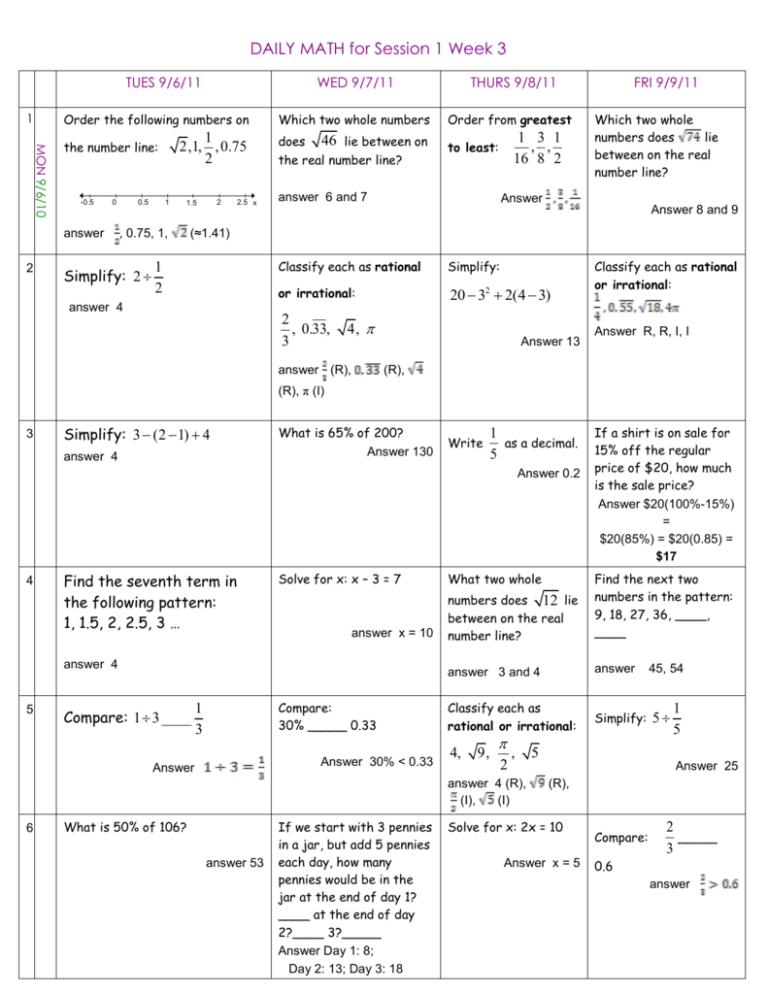
DAILY MATH for Session 1 Week 3 TUES 9/6/11 Order the following numbers on 1 MON 9/6/10 1 2,1, , 0.75 2 the number line: -0.5 0 answer 2 WED 9/7/11 0.5 1 , 0.75, 1, Simplify: 2 2 1.5 2.5 x THURS 9/8/11 Which two whole numbers Order from greatest does to least: 46 lie between on the real number line? answer 6 and 7 1 3 1 , , 16 8 2 FRI 9/9/11 Which two whole numbers does lie between on the real number line? Answer Answer 8 and 9 (≈1.41) 1 2 answer 4 Classify each as rational Simplify: or irrational: 20 32 2(4 3) 2 , 0.33, 3 4, answer (R), Answer 13 Classify each as rational or irrational: Answer R, R, I, I (R), (R), π (I) 3 Simplify: 3 (2 1) 4 answer 4 What is 65% of 200? Answer 130 Write 1 as a decimal. 5 Answer 0.2 4 Find the seventh term in the following pattern: 1, 1.5, 2, 2.5, 3 … Solve for x: x – 3 = 7 answer x = 10 answer 4 5 Compare: 1 3 ____ Compare: 30% _____ 0.33 1 3 Answer 30% < 0.33 Answer What two whole numbers does 12 lie between on the real number line? Find the next two numbers in the pattern: 9, 18, 27, 36, ____, ____ answer 3 and 4 answer 45, 54 Classify each as rational or irrational: Simplify: 5 4, 9, 2 , answer 4 (R), (I), (I) 6 What is 50% of 106? answer 53 If we start with 3 pennies in a jar, but add 5 pennies each day, how many pennies would be in the jar at the end of day 1? ____ at the end of day 2?____ 3?_____ Answer Day 1: 8; Day 2: 13; Day 3: 18 If a shirt is on sale for 15% off the regular price of $20, how much is the sale price? Answer $20(100%-15%) = $20(85%) = $20(0.85) = $17 1 5 5 Answer 25 (R), Solve for x: 2x = 10 Answer x = 5 Compare: 2 _____ 3 0.6 answer 7 What percent of 30 is 3? answer What percent of 38 is 15? Answer What is 60% of 14 m? Answer: 14m (0.60) = 8.4 m 16 inches is 40% of what? Answer: EXPLANATORY NOTES Every integer can be “squared”—that is, multiplied by itself to get another integer. For example, 5 “squared” is 5 x 5 = 25. For integers, this process can be visualized as taking 25 objects and arranging them in a square—with 5 rows of 5 objects each. The number of objects is the square (25 in this example) and the number of rows and number of objects in each row is the square root (5 in this example). Only certain numbers of objects can be arranged in a square. These are the perfect squares. For example, we can put 16 objects into a square (4 rows of 4 each) and we can put 25 objects into a square (5 rows of 5 each). But we can’t put 20 objects into a square (at least, we can’t without cutting the objects into pieces). We say that 20 does not have a rational square root. But does 20 have an irrational square root? If we shift our perspective away from squares of counted objects towards squares with measured sides, the idea of squares and square roots expands. In this new context, it is perfectly conceivable to have a square with sides 4.5 inches each, with an area of 4.5 in. x 4.5 in. = 20.25 in2. In this new context, the area is the square and the length of each side is the square root. Is it possible to have a square with an area of exactly 20 in2? Of course, each side would have to be a smidge less than 4.5 inches long. (We know that 4.5 x 4.5 = 20.25—a smidge more than 20 exactly). Thus, the square root of 20 exists, but isn’t a neat clean terminating decimal. Irrational square roots (those not associated with perfect squares) can be approximated to however many decimal places you wish, but can never be exactly written down completely. Their decimal representations never terminate and never repeat. Finally, remember that many fractions and decimals are also perfect squares. For example, we just saw that 20.25 is a perfect square because it is exactly equal to 4.52. Similarly, is a perfect square because it is exactly equal to . Thus, are all rational numbers, but is an irrational number (whose decimal approximation begins 4.472135955 . . .). The only way to write an irrational number exactly is to write its symbolic form, such as or π. This often means that is a better answer than 4.472135955. However, at other times, such as for graphing, plotting, measuring, and estimating, you will prefer to use the approximate decimal form of an irrational number.





